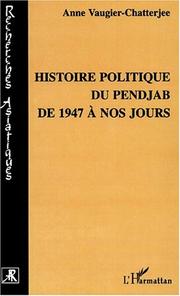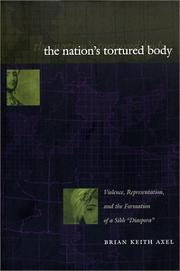| Listing 1 - 3 of 3 |
Sort by
|
Book
Abstract | Keywords | Export | Availability | Bookmark
 Loading...
Loading...Choose an application
- Reference Manager
- EndNote
- RefWorks (Direct export to RefWorks)
On the life and times of Ranjit Singh, Maharaja of the Punjab, 1780-1839.
Sikhs --- Kings and rulers --- Ranjit Singh, --- Punjab (India) --- Punjab (India) --- Kings and rulers --- History.

ISBN: 2747512045 Year: 2001 Publisher: Paris : Harmattan,
Abstract | Keywords | Export | Availability | Bookmark
 Loading...
Loading...Choose an application
- Reference Manager
- EndNote
- RefWorks (Direct export to RefWorks)
Punjab (India) --- Pendjab --- Politics and government --- History --- Politique et gouvernement --- Histoire --- Sikhs --- Political activity --- Political activity.

ISBN: 0822326159 0822398443 Year: 2001 Publisher: Durham, [N.C.] : Duke University Press,
Abstract | Keywords | Export | Availability | Bookmark
 Loading...
Loading...Choose an application
- Reference Manager
- EndNote
- RefWorks (Direct export to RefWorks)
In The Nation’s Tortured Body Brian Keith Axel explores the formation of the Sikh diaspora and, in so doing, offers a powerful inquiry into conditions of peoplehood, colonialism, and postcoloniality. Demonstrating a new direction for historical anthropology, he focuses on the position of violence between 1849 and 1998 in the emergence of a transnational fight for Khalistan (an independent Sikh state). Axel argues that, rather than the homeland creating the diaspora, it has been the diaspora, or histories of displacement, that have created particular kinds of places—homelands.Based on ethnographic and archival research conducted by Axel at several sites in India, England, and the United States, the text delineates a theoretical trajectory for thinking about the proliferation of diaspora studies and area studies in America and England. After discussing this trajectory in relation to the colonial and postcolonial movement of Sikhs, Axel analyzes the production and circulation of images of Sikhs around the world, beginning with visual representations of Maharaja Duleep Singh, the last Sikh ruler of Punjab, who died in 1893. He argues that imagery of particular male Sikh bodies has situated—at different times and in different ways—points of mediation between various populations of Sikhs around the world. Most crucially, he describes the torture of Sikhs by Indian police between 1983 and the present and discusses the images of tortured Sikh bodies that have been circulating on the Internet since 1996. Finally, he returns to questions of the homeland, reflecting on what the issues discussed in The Nation's Tortured Body might mean for the ongoing fight for Khalistan.Specialists in anthropology, history, cultural studies, diaspora studies, and Sikh studies will find much of interest in this important work.
Sikh diaspora. --- Sikhs --- Ethnology --- Religious adherents --- Diaspora, Sikh --- East Indian diaspora --- Human geography --- Diaspora --- Migrations --- Punjab (India) --- Panjab (India) --- Pañjāba (India) --- Пенджаб (India) --- East Punjab (India) --- Patiala and East Punjab States Union (India) --- Emigration and immigration. --- History --- Autonomy and independence movements.
| Listing 1 - 3 of 3 |
Sort by
|

 Search
Search Feedback
Feedback About
About Help
Help News
News